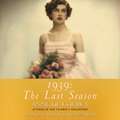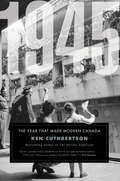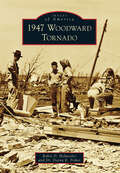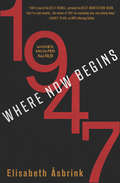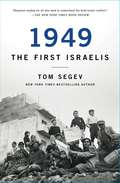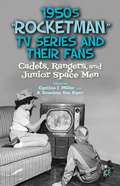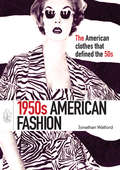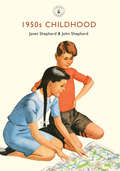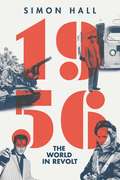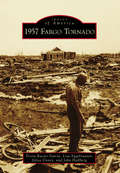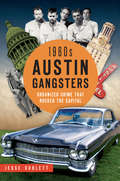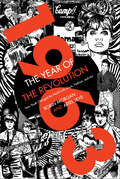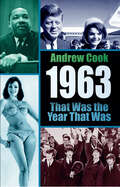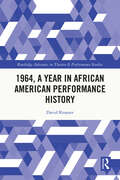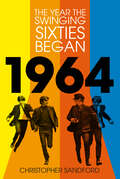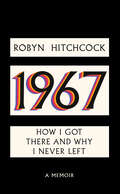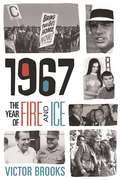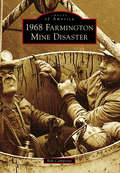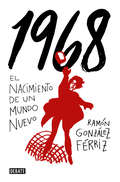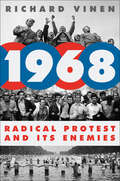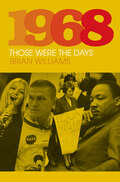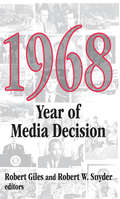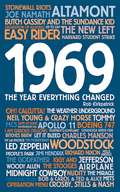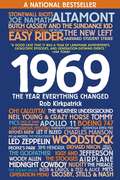- Table View
- List View
1939: The Last Season
by Anne de CourcyA wonderful portrait of British upper-class life in the Season of 1939 - the last before the Second World War.The Season of 1939 brought all those 'in Society' to London. The young debutante daughters of the upper classes were presented to the King and Queen to mark their acceptance into the new adult world of their parents. They sparkled their way through a succession of balls and parties and sporting events.The Season brought together influential people not only from Society but also from Government at the various events of the social calendar. Prime Minister Neville Chamberlain chaperoned his debutante niece to weekend house parties; Lord Halifax, the Foreign Secretary, lunched with the Headmaster of Eton; Cabinet Ministers encountered foreign Ambassadors at balls in the houses of the great hostesses. As the hot summer drew on, the newspapers filled with ever more ominous reports of the relentless progress towards war. There was nothing to do but wait - and dance. The last season of peace was nearly over.
1945: The Year That Made Modern Canada
by Ken CuthbertsonIt was a watershed year for Canada and the world. 1945 set Canada on a bold course into the future. A huge sense of relief marked the end of hostilities. Yet there was also fear and uncertainty about the perilous new world that was unfolding in the wake of the American decision to use the atomic bomb to bring the war in the Pacific to a dramatic halt. On the eve of WWII, the Dominion of Canada was a sleepy backwater still struggling to escape the despair of the Great Depression. But the war changed everything. After six long years of conflict, sacrifice and soul-searching, the country emerged onto the world stage as a modern, confident and truly independent nation no longer under the colonial sway of Great Britain. Ken Cuthbertson has written a highly readable narrative that commemorates the seventy-fifth anniversary of the end of WWII and chronicles the events and personalities of a critical year that reshaped Canada. 1945: The Year That Made Modern Canada showcases the stories of people—some celebrated, some ordinary—who left their mark on the nation and helped create the Canada of today. The author profiles an eclectic group of Canadians, including eccentric prime minister Mackenzie King, iconic hockey superstar Rocket Richard, business tycoon E. P. Taylor, Soviet defector Igor Gouzenko, the bandits of the Polka Dot Gang, crusading MP Agnes Macphail, and authors Gabrielle Roy and Hugh MacLennan, among many others. The book also covers topics like the Halifax riots, war brides, the birth of Canada’s beloved social safety net, and the remarkable events that sparked the Cold War. 1945 is the unforgettable story of our nation at the moment of its modern birth.
1947 Woodward Tornado (Images of America)
by Robin D. Hohweiler Dr. Deena FisherThe 1947 Woodward Tornado remains the deadliest tornado in Oklahoma history, leaving more than 100 people dead and nearly 1,000 seriously injured. The tornado struck the city of Woodward under cover of darkness and without warning at 8:42 p.m. on April 9, 1947. The storm left in its wake hundreds of stories of tragic loss, devastation, and even mysteries that remain unsolved. These include the three unidentified girls--one as young as six months--whose bodies have remained unclaimed, as well as the mystery of what happened to Joan Gay Croft, a girl who disappeared from the local hospital on the night of the storm. Croft's disappearance was featured in an episode of the television show Unsolved Mysteries in the early 1990s. There is also the oft-overlooked story of those who took up residence (some for more than a year) in "Tornado Town" west of the city and found some glimmer of hope in an otherwise hopeless situation.
1947: Where Now Begins
by Fiona Graham Elisabeth ÅsbrinkAn award-winning writer captures a year that defined the modern world, intertwining historical events around the globe with key moments from her personal history.The year 1947 marks a turning point in the twentieth century. Peace with Germany becomes a tool to fortify the West against the threats of the Cold War. The CIA is created, Israel is about to be born, Simone de Beauvoir experiences the love of her life, an ill George Orwell is writing his last book, and Christian Dior creates the hyper-feminine New Look as women are forced out of jobs and back into the home. In the midst of it all, a ten-year-old Hungarian-Jewish boy resides in a refugee camp for children of parents murdered by the Nazis. This year he has to make the decision of a lifetime, one that will determine his own fate and that of his daughter yet to be born, Elisabeth.
1949 the First Israelis: The First Israelis
by Tom SegevRenowned historian Tom Segev strips away national myths to present a critical and clear-eyed chronicle of the year immediately following Israel’s foundation.“Required reading for all who want to understand the Arab-Israeli conflict…the best analysis…of the problems of trying to integrate so many people from such diverse cultures into one political body” (The New York Times Book Review). Historian and journalist Tom Segev stirred up controversy in Israel upon the first publication of 1949. It was a landmark book that told a different story of the country’s early years, one that wasn’t taught in schools or shown in popular culture. Rather than painting the idealized picture of the Israel’s founding in 1948, after the wreckage of the Holocaust, Segev reveals gritty underside behind the early years. The new country of Israel faced challenges on all sides. Day-to-day life was severe, marked by austerity and food shortages; Israeli society was fractured between traditional and secular camps; Jewish immigrants from Middle-Eastern countries faced discrimination and second-class treatment; and clashes between settlers and the Arabs would set the tone for relations for the following decades, hardening attitudes and creating a violent cycle of retaliation. Drawing on journal entries, letters, declassified government documents, and more, 1949 is a richly detailed look at the friction between the idealism of the Zionist movement and the cold realities of history. Decades after its publication in the United States, Segev’s groundbreaking book is still required reading for anyone who wants to understand Israel’s past and future.
1950s "Rocketman" TV Series and Their Fans
by Cynthia J. MillerThe fourteen essays featured here focus on series such as Space Patrol, Tom Corbett, and Captain Z-Ro, exploring their roles in the day-to-day lives of their fans through topics such as mentoring, promotion of the real-world space program, merchandising, gender issues, and ranger clubs - all the while promoting the fledgling medium of television.
1950s American Fashion
by Jonathan WalfordThe 1950s was the first decade when American fashion became truly American. The United States had always relied on Europe for its style leads, but during World War II, when necessity became the mother of invention, the country had to find its own way. American designers looked to what American women needed and found new inspirations for American fashion design. Sportswear became a strength, but not at the expense of elegance. Easy wear materials were borrowed for producing more formal clothes, and versatile separates and adaptable dress and jacket suits became hallmarks of American style. This book follows the American fashion industry, from New York's 7th Avenue to the beaches of California in search of the clothes that designed 1950s American fashion.
1950s Childhood
by Janet ShepherdThe generation who grew up in Britain immediately after the Second World War are popularly called 'The Baby Boomers'. As children, they experienced life in Britain from wartime austerity to the relative affluence of the late 1950s. Uniquely healthier and wealthier than previous generations, this first welfare state generation received free orange juice, milk and cod liver oil to safeguard their health. However, their overall diet was restricted until rationing fully ended in 1954 - and the permissive society had yet to arrive. Janet and John Shepherd explore how the Baby Boomers grew up through the change from post-war restrictions to a new consumer society, enjoying increased choice in the shops, while at home, pirate Radio Luxembourg and flickering black and white television opened up new vistas.
1956: The World in Revolt
by Simon HallVibrantly and perceptively told, this is the story of one remarkable year--a vivid history of exhilarating triumphs and shattering defeats around the world. 1956 was one of the most remarkable years of the twentieth century. All across the globe, ordinary people spoke out, filled the streets and city squares, and took up arms in an attempt to win their freedom. In this dramatic, page-turning history, Simon Hall takes the long view of the year's events--putting them in their post-war context and looking toward their influence on the counterculture movements of the 1960s--to tell the story of the year's epic, global struggles from the point of view of the freedom fighters, dissidents, and countless ordinary people who worked to overturn oppressive and authoritarian systems in order to build a brave new world. It was an epic contest. 1956 is the first narrative history of the year as a whole--and the first to frame its tumultuous events as part of an interconnected, global story of revolution.
1957 Fargo Tornado (Images of America)
by John Hallberg Trista Raezer-Stursa Lisa Eggebraaten Jylisa DoneyOn the evening of June 20, 1957, a tornado ripped through Fargo, North Dakota. It caused the deaths of seven children and five adults and left 116 injured. The tornado destroyed 359 buildings and damaged 2,543 more. The nine-mile path of destruction covered over 66 blocks in town, leaving more than 2,000 people homeless and causing approximately $20 million worth of damage. Following the tornado, first responders quickly united to aid those in need, setting up disaster headquarters, finding shelter for over 600 people, and distributing more than 100 tons of clothing and bedding. Dr. Tetsuya Fujita, a meteorologist, studied the Fargo tornado when creating the Fujita scale (F-scale) and later rated it an F5, the most destructive rating. Images of America: 1957 Fargo Tornado, shines a light on the tornado's destruction and the rebuilding of a united and vibrant community.
1960s Austin Gangsters: Organized Crime that Rocked the Capital (True Crime)
by Jesse SublettTimmy Overton of Austin and Jerry Ray James of Odessa were football stars who traded athletics for lives of crime. The original rebels without causes, nihilists with Cadillacs and Elvis hair, the Overton gang and their associates formed a ragtag white trash mafia that bedazzled Austin law enforcement for most of the 1960s. Tied into a loose network of crooked lawyers, pimps and used car dealers who became known as the "traveling criminals," they burglarized banks and ran smuggling and prostitution rings all over Texas. Author Jesse Sublett presents a detailed account of these Austin miscreants, who rose to folk hero status despite their violent criminal acts.
1963: How Youth Changed the World with Music, Fashion, and Art
by Robin Morgan Ariel LeveBeginning in London and ricocheting across the Atlantic, 1963: The Year of the Revolution is an oral history of twelve months that changed our world—the Youth Quake movement—and laid the foundations for the generation of today.Ariel Leve and Robin Morgan's oral history is the first book to recount the kinetic story of the twelve months that witnessed a demographic power shift—the rise of the Youth Quake movement, a cultural transformation through music, fashion, politics, theater, and film. Leve and Morgan detail how, for the first time in history, youth became a commercial and cultural force with the power to command the attention of government and religion and shape society.While the Cold War began to thaw, the race into space heated up, feminism and civil rights percolated in politics, and JFK’s assassination shocked the world, the Beatles and Bob Dylan would emerge as poster boys and the prophet of a revolution that changed the world.1963: The Year of the Revolution records, documentary-style, the incredible roller-coaster ride of those twelve months, told through the recollections of some of the period’s most influential figures—from Keith Richards to Mary Quant, Vidal Sassoon to Graham Nash, Alan Parker to Peter Frampton, Eric Clapton to Gay Talese, Stevie Nicks to Norma Kamali, and many more.
1963: That Was the Year That Was
by Andrew CookA compendium of milestone stories and watershed events in popular culture, national and international politics from 1963, including: The Beatles' first No 1, the coldest winter since 1740, Martin Luther King's 'I Have a Dream' speech, the Great Train Robbery, the Profumo Affair, Ian Brady and Myra Hindley's killings, the first woman in Space, Valentina Tereshkova, James Bond becomes an international phenomenon, 70,000 protest against nuclear weapons in London, Harold Wilson's election, and the onset of 'new politics' and satire, the assassination of JFK, the BBC launch of Doctor Who.
1964, A Year in African American Performance History (ISSN)
by David KrasnerThis book examines the Civil Rights Movement from the perspective of a single year, 1964.The book analyses specific events that occurred in 1964 as benchmarks of the Civil Right Movement, making the case that 1964 was a watershed year. Each chapter considers individually politics, rhetoric, sports, dramatic literature, film, art, and music, breaking down the events and illustrating their importance to the social and political life in the United States in 1964. This study emphasizes 1964 as a nodal point in the history of the Civil Rights Movement, arguing that it was within this single year that the tide against racism and injustice turned markedly.This book will be of great interest to the scholars and students of civil rights, theatre and performance, art history, and drama literature.
1964: The Year the Swinging Sixties Began
by Christopher SandfordStep back in time to 1964, a year of cultural upheaval and political transformation. From the rise of the Civil Rights movement in the United States to the global phenomenon of Beatlemania, this was the year that gave us bold fashion, unforgettable music and social change that continues to shape society across the world today.While Britain’s new Labour government promised the ‘white heat of technology’, on the world stage 1964 saw the escalation of the Vietnam War, Nelson Mandela’s sentence to life imprisonment and the continued brinkmanship of the global arms race. Brand-new subcultures clashed at Margate beach, where thousands of Mods and Rockers fought over their differing values, while London’s Carnaby Street shone vibrantly in the country’s capital and women flocked to Mary Quant’s iconic designs, empowered by changing social sensibilities and rising hemlines.In this captivating blend of historical events, cultural trends and personal anecdotes, Christopher Sandford tells the full and colourful story of the year that ushered in the modern era.
1967: How I Got There and Why I Never Left
by Robyn HitchcockThe great eccentric of British psychedelia—beloved by everyone from Led Zeppelin and R.E.M. to the late Jonathan Demme—pens a singularly unique childhood memoir . . . “A bright, nostalgic look at the exhilaration of 1967, this book—illustrated throughout with Hitchcock’s surreal sketches—will appeal to not only the author’s many fans but also anyone interested in the music and culture from the golden age of psychedelia. Wistfully reflective reading.” —Kirkus Reviews “Memoirists rarely begin their work with a stroke of genuine inspiration, and Robyn Hitchcock’s ingenious idea to limit his account of his life to the titular year gives this sharp, funny, finely written book an unusually keen, wistful intensity without sacrificing its sense of the breathtaking sweep of time. I absolutely adored every line of 1967 and every moment I spent reading it.” —Michael Chabon, author of Telegraph Avenue 1967: HOW I GOT THERE AND WHY I NEVER LEFT explores how that pivotal slice of time tastes to a bright, obsessive-compulsive boy who is shipped off to a hothouse academic boarding school as he reaches the age of thirteen—just as Bob Dylan’s Highway 61 Revisited starts to bite, and the Beatles’s Sgt. Pepper’s Lonely Hearts Club Band explodes. When he arrives in January 1966, Robyn Hitchcock is still a boy pining for the comforts of home and his family’s loving au pair, Teresa. By December 1967, he’s mutated into a 6’2? tall rabid Bob Dylan fan, whose two ambitions in life are to get really high and fly to Nashville. In between—as the hippie revolution blossoms in the world outside—Hitchcock adjusts to the hierarchical, homoerotic world of Winchester, threading a path through teachers with arrested development, some oafish peers, and a sullen old maid—a very English freak show. On the way he befriends a cadre of bat-winged teenage prodigies and meets their local guru, the young Brian Eno. At the end of 1967, all the ingredients are in place that will make Robyn Hitchcock a songwriter for life. But then again, does 1967 ever really end?
1967: The Year of Fire and Ice
by Victor BrooksBlazing hot meets icy cool in a momentous year in US historyOn New Year’s Day in 1967, the 200 million Americans who lived in the United States were about to experience a fascinating, exciting, and sometimes bewildering twelve months that for many formed an iconic portion of their lives. Despite the fact that the coming year produced no Black Friday, Pearl Harbor, or 9/11 attack, the nation still underwent dramatic changes in everything from support for the Vietnam War to approval of candidates for the 1968 presidential election to attitudes toward sex with strangers and what constitutes the status quo. Almost without significant forewarning, Americans in 1967 witnessed a simultaneous cooling of Cold War tensions with the Soviet Union while the war in Vietnam exploded into a white-hot conflict that inflicted nearly two hundred American battle deaths a week. Meanwhile, young people at home were alternately listening to the “cool” sound of the Beatle’s new “Sgt. Pepper” album and Jim Morrison’s plea to get ever higher in “Light my Fire.” On television an emotional, passionate James T. Kirk shared an Enterprise bridge with the cool and logical Mr. Spock.Victor Brooks explores what happened—and in some cases, did not happen—to these two hundred million Americans in a national roller coaster ride that was the year 1967. He chronicles a society that proportionally had far more young people than was the case five decades later, with a widely publicized generation gap that produced more arguments, tension, and anguish between young and old Americans than any 21st century counterpart. 1967 is a fascinating, wide-ranging exploration including topics ranging from the first Super Bowl, the beginning of the 1968 presidential campaign, the social impact of the “Summer of Love” in San Francisco, and the American combat experience in an expanding war in Vietnam. The book represents a reunion of sorts for Baby Boomers as well as a guidebook for younger readers on how their elders coped with one of the definitive years of a pivotal decade.
1968 Farmington Mine Disaster (Images of America)
by Bob CampioneCoal in the United States was discovered in the 18th century by landowners and farmers on the slopes of the hillsides in the Appalachian region. It was not until the late 19th century that this black rock would become a part of an industrial revolution. One of the first mines to commercially produce coal was in Fairmont, West Virginia, and began the Consolidated Coal Corporation. On November 20, 1968, the Farmington No. 9 mine explosion changed the course of safety for future mining and the lives of 78 families whose sons, husbands, fathers, and loved ones never came back from the cateye shift the next day.
1968: El nacimiento de un mundo nuevo
by Ramón González FérrizUn recorrido por el revolucionario 1968, el año en que se rebelaron los jóvenes de todo el mundo. 1968 se ha convertido en una especie de mito. Pero más allá de esa imagen idílica o confusa, fue un año lleno de acontecimientos políticos que provocaron la extendida sensación de que el mundo estaba al borde del colapso. En Francia y en Estados Unidos, en Checoslovaquia, México, Japón, Italia, Alemania y España, 1968 fue el año en que los sistemas políticos fueron cuestionados, sobre todo, por unos jóvenes estudiantes convencidos de que el mundo que les legaban sus padres era aburrido, injusto y criminal. Sin un plan concreto, pero armados con nuevas ideologías de izquierdas, una retórica audaz y unas tácticas de protesta que imitaban a las de las guerrillas, rompieron los grandes consensos políticos y culturales que habían estado en pie desde el final de la Segunda Guerra Mundial. 1968. El nacimiento de un mundo nuevo es una crónica de ese convulso año de grandes esperanzas y de sueños de un mundo mejor, pero también lleno de muertes violentas como las de Martin Luther King y Bobby Kennedy y disturbios como los de París, Tokio, Roma, Berlín y Madrid. Fue el año en que gobiernos como el de México se volvieron contra sus ciudadanos, las fuerzas del Pacto de Varsovia invadieron Checoslovaquia, se estableció el embrión de varios grupos terroristas como la Fracción del Ejército Rojo y las Brigadas Rojas, y ETA cometió su primer asesinato. Todo ello con el trasfondo ineludible de la guerra de Vietnam.
1968: El nacimiento de un mundo nuevo
by Ramón González FérrizUn recorrido por el revolucionario 1968, el año en que se rebelaron los jóvenes de todo el mundo. 1968 se ha convertido en una especie de mito. Pero más allá de esa imagen idílica o confusa, fue un año lleno de acontecimientos políticos que provocaron la extendida sensación de que el mundo estaba al borde del colapso. En Francia y en Estados Unidos, en Checoslovaquia, México, Japón, Italia, Alemania y España, 1968 fue el año en que los sistemas políticos fueron cuestionados, sobre todo, por unos jóvenes estudiantes convencidos de que el mundo que les legaban sus padres era aburrido, injusto y criminal. Sin un plan concreto, pero armados con nuevas ideologías de izquierdas, una retórica audaz y unas tácticas de protesta que imitaban a las de las guerrillas, rompieron los grandes consensos políticos y culturales que habían estado en pie desde el final de la Segunda Guerra Mundial. 1968. El nacimiento de un mundo nuevo es una crónica de ese convulso año de grandes esperanzas y de sueños de un mundo mejor, pero también lleno de muertes violentas como las de Martin Luther King y Bobby Kennedy y disturbios como los de París, Tokio, Roma, Berlín y Madrid. Fue el año en que gobiernos como el de México se volvieron contra sus ciudadanos, las fuerzas del Pacto de Varsovia invadieron Checoslovaquia, se estableció el embrión de varios grupos terroristas como la Fracción del Ejército Rojo y las Brigadas Rojas, y ETA cometió su primer asesinato. Todo ello con el trasfondo ineludible de la guerra de Vietnam.
1968: Radical Protest and Its Enemies
by Richard VinenA major new history of one of the seminal years in the postwar world, when rebellion and disaffection broke out on an extraordinary scale.The year 1968 saw an extraordinary range of protests across much of the western world. Some of these were genuinely revolutionary—around ten million French workers went on strike and the whole state teetered on the brink of collapse. Others were more easily contained, but had profound longer-term implications—terrorist groups, feminist collectives, gay rights activists could all trace important roots to 1968.1968 is a striking and original attempt half a century later to show how these events, which in some ways still seem so current, stemmed from histories and societies which are in practice now extraordinarily remote from our own time. 1968 pursues the story into the 1970s to show both the ever more violent forms of radicalization that stemmed from 1968 and the brutal reaction that brought the era to an end.
1968: Those Were the Days
by Brian Williams1968 was the year when humans first glimpsed the far side of the Moon, but also the year the world was shocked by assassination, by the crushing of hope for reform and by wars that showed no sign of ever ending. To the old there seemed too much change, too quickly, with youth in revolt, though against what no one was entirely sure … ‘Hey Jude’, sang the Beatles, with a refrain that lingered long into the summer night, ‘Don’t make it bad, take a sad song and make it better’...
1968: Year of Media Decision
by Robert Giles Robert W. SnyderThirty years ago American political life was all relentless, painful, and confounding: the Tet Offensive brought new intensity to the Vietnam War; President Lyndon Johnson would not seek re-election; Martin Luther King, Jr. and Robert Kennedy were assassinated; student protests rocked France; a Soviet invasion ended "socialism with a human face" in Czechoslovakia; the Mexican government massacred scores of peaceful demonstrators; and Richard M. Nixon was elected president. Any one of the events of 1968 bears claim to historical significance. Together they set off shock waves that divided Americans into new and contending categories: hawks and doves, old and young, feminists and chauvinists, straights and hippies, blacks and whites, militants and moderates. As citizens alive to their own time and as reporters responsible for making sense of it, journalists did not stand aside from the conflicts of 1968. In their lives and in their work, they grappled with momentous issues--war, politics, race, and protest.
1969
by Rob KirkpatrickFor the fortieth anniversary of 1969, Rob Kirkpatrick takes a look back at a year when America witnessed many of the biggest landmark achievements, cataclysmic episodes, and generation-defining events in recent history. 1969 was the year that saw Apollo 11 land on the moon, the Cinderella stories of Joe Namath's Jets and the "Miracle Mets," the Harvard student strike and armed standoff at Cornell, the People's Park riots, the first artificial heart transplant and first computer network connection, the Manson family murders and cryptic Zodiac Killer letters, the Woodstock music festival, Easy Rider, Kurt Vonnegut's Slaughterhouse-Five, the Battle of Hamburger Hill, the birth of punk music, the invasion of Led Zeppelin, the occupation of Alcatraz, death at Altamont Speedway, and much more. It was a year that pushed boundaries on stage (Oh! Calcutta!), screen (Midnight Cowboy), and the printed page (Everything You Always Wanted to Know about Sex), witnessed the genesis of the gay rights movement at Stonewall, and started the era of the "no fault" divorce. Richard Nixon became president, the New Left squared off against the Silent Majority, William Ayers co-founded the Weatherman Organization, and the nationwide Moratorium provided a unifying force in the peace movement. Compelling, timely, and quite simply a blast to read, 1969 chronicles the year through all its ups and downs, in culture and society, sports, music, film, politics, and technology. This is a book for those who survived 1969, or for those who simply want to feel as alive as those who lived through this time of amazing upheaval.
1969: The Year Everything Changed
by Rob KirkpatrickFEATURING A NEW INTRODUCTION, THIS IS THE SEMINAL AND CLASSIC BOOK ON THE YEAR THAT DEFINED A GENERATION! 1969. The very mention of this year summons indelible memories. Woodstock and Altamont. Charles Manson and the Zodiac Killer. The televised events of the moon landing and Ted Kennedy’s address after Chappaquiddick. The Amazin’ Mets and Broadway Joe’s Jets. The Stonewall Riots and the Days of Rage. Americans pushed new boundaries on stage, screen, and the printed page. The first punk and metal albums hit the airwaves. Swinger culture became chic. The Santa Barbara oil slick and Cuyahoga River fire highlighted growing ecological devastation. The nationwide Moratorium and the breaking story of the My Lai massacre inspired impassioned debate on the Vietnam War. Richard Nixon spoke of “The Silent Majority” while John and Yoko urged us to “Give Peace a Chance.” In this rich and comprehensive narrative, Rob Kirkpatrick chronicles an unparalleled year in American society in all its explosive ups and downs.
